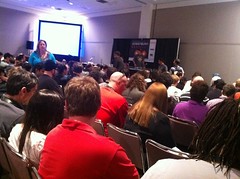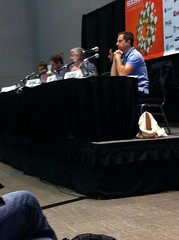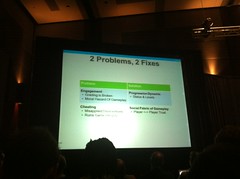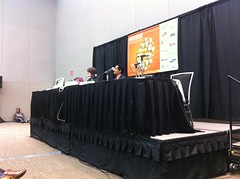#SWSXi 2011 Day 2 Experience
 The second day of SXSW 2011 is now complete. It was a much longer and fuller day than yesterday with sessions beginning at 9:30 AM and ending around 6 PM.A few general observations:
The second day of SXSW 2011 is now complete. It was a much longer and fuller day than yesterday with sessions beginning at 9:30 AM and ending around 6 PM.A few general observations:
- It is even bigger than last year with more people, more sessions and covering a larger geographical area (requiring more walking). It is overwhelming, exhilarating and draining all at the same time.
- Location is not going away; it is becoming even more relevant and everyone is trying to figure out how to get mainstream audiences to see its wonderfulness and start using it.
- Game play -- social, location-based, fun -- is growing, growing, growing.
- There is so much going on here in Austin, and I am only experiencing a small sliver of it. The rest of it, I am reading about just like everyone else at home. I didn't see Jake Gyllenhaal yesterday, nor did I see Ashton and Demi or Conan today.
- I have figured out that my iPad is sufficient for note taking/blogging throughout the day, so I am relegating the laptop to the hotel room for the rest of the trip. I need to lighten the load on my shoulder. So, that probably means no more live-blogging, but instead just posting my raw notes at the conclusion of each session (like I did the second part of this day after my computer battery died).
- I packed seven pairs of shoes and will probably wear just one pair all week.
Today, I covered the following sessions:
- Location-Based Game Design
- Banking on Big Brands/Celebs for the Web
- Brand Journalism: The Rise of Non-Fiction Advertising
- Seth Priebatsch of scvngr Keynote Presentation
- Storytelling Through Advertising: Engaging Players in Online Games
- Metric-Driven Design
I either live-blogged or posted my raw notes for all of these sessions to this blog. Outlined below are my key takeaways and thoughts from each session.
Location-Based Game Design
Here is the link to the official session description and here is a link to my live-blogging session.Key takeaway: Gaming is going to continue to evolve with the integration of real world spaces with online activity. Foursquare was just the beginning. Check-ins are just one type of "play." Location and play are moving closer together and the game possibilities are pretty cool. For a non-gamer like me, the best example of this was Seek & Spell. With Seek & Spell, the user establishes a game in their existing space; letters are then dropped into the defined space on their phones. The players have to run to that space physically to pick up the letter digitally. They then have to spell words with letters they collect. With multiple users participating and all seeing the same available letters, there can be physical running races to collect the letters. Here is a video demonstration:
Foursquare was just the beginning. Check-ins are just one type of "play." Location and play are moving closer together and the game possibilities are pretty cool. For a non-gamer like me, the best example of this was Seek & Spell. With Seek & Spell, the user establishes a game in their existing space; letters are then dropped into the defined space on their phones. The players have to run to that space physically to pick up the letter digitally. They then have to spell words with letters they collect. With multiple users participating and all seeing the same available letters, there can be physical running races to collect the letters. Here is a video demonstration:
Seek ’n Spell gameplay video from Retronyms on Vimeo.
The presenters talked about other games they are developing that integrate location and gaming, so I am definitely not doing justice to their talent and creativity. But trust me, it is cool stuff.
Banking on Big Brands/Celebs for the Web
Here is a link to the official session description and here is a link to my live-blogging session.Key takeaway: When working with celebrities for paid endorsements, engage them as part of the process rather than treating them as paid talent and your brand will reap the rewards. Best quote of the session: "In the creative community, if you are not creating, you are waiting." -- Kevin Pollack. Celebrities are, at their core, artists. They don't want to be paid to show up. They want to be paid for their art. They don't always get the opportunity to feel like artists in Hollywood, to have their voices heard and to contribute to the process. Offer that and they are more likely to be a true brand ambassador.
Best quote of the session: "In the creative community, if you are not creating, you are waiting." -- Kevin Pollack. Celebrities are, at their core, artists. They don't want to be paid to show up. They want to be paid for their art. They don't always get the opportunity to feel like artists in Hollywood, to have their voices heard and to contribute to the process. Offer that and they are more likely to be a true brand ambassador.
Brand Journalism: The Rise of Non-Fiction Advertising
Here is the link to the official session description and here is a link to my live-blogging session.Key takeaway: Content is king and even brands have to participate in content generation to get noticed in the stream. Content from a brand is not something consumers seek out. Brands and agencies don't know how to generate content. When content generation (aka, journalism) is done wrong, it can hurt a brand. Content generation is exceptionally difficult for a brand to do (hint: those that are doing it are hiring trained journalists). All this can be pushed aside when content generation is done right.Who is doing/did it right? Pepsi Refresh Project, the Church of Latter-Day Saints, Ford Bold Moves.Who is doing/did it wrong? Chrysler. Mainly for their agency firing the person who tweeting the "f" word and for Chrysler firing the agency. The panel unanimously agreed on this point. Chrysler made a mistake by making such a big deal out of this.This was, by far, my favorite session of the day. Bob Garfield was delightfully clever and a great panel moderator. The panel was chock-full of really impressive ad guys. The conversation was relevant to current events. I usually dislike panel discussions, but this team did it well and did it right.
Content from a brand is not something consumers seek out. Brands and agencies don't know how to generate content. When content generation (aka, journalism) is done wrong, it can hurt a brand. Content generation is exceptionally difficult for a brand to do (hint: those that are doing it are hiring trained journalists). All this can be pushed aside when content generation is done right.Who is doing/did it right? Pepsi Refresh Project, the Church of Latter-Day Saints, Ford Bold Moves.Who is doing/did it wrong? Chrysler. Mainly for their agency firing the person who tweeting the "f" word and for Chrysler firing the agency. The panel unanimously agreed on this point. Chrysler made a mistake by making such a big deal out of this.This was, by far, my favorite session of the day. Bob Garfield was delightfully clever and a great panel moderator. The panel was chock-full of really impressive ad guys. The conversation was relevant to current events. I usually dislike panel discussions, but this team did it well and did it right.
Seth Priebatsch of scvngr Keynote Presentation
Here is a link to the official session description and here is a link to my raw notes from the session.Key takeaway: Last decade was all about social; the coming decade will be all about gaming. Gaming can influence and change everything we do from business to school to world-wide change. Basically, Priebatsch's point was that game mechanics can be used in any situation to drive results from the targeted audience. Incorporating a different rewards system, involving team/communal aspects and instilling time limits all are ways of changing the way people engage in various activities, thereby making them a game rather than a chore.
Basically, Priebatsch's point was that game mechanics can be used in any situation to drive results from the targeted audience. Incorporating a different rewards system, involving team/communal aspects and instilling time limits all are ways of changing the way people engage in various activities, thereby making them a game rather than a chore.
Storytelling Through Advertising: Engaging Players in Online Games
Here is the link to the official session overview and here is the link to my raw notes from the session.Key takeaway: A ton of people are playing online social games like Farmville, the majority are women (moms), and the game companies are willing to do just about anything to integrate a brand into the game (given the right amount of money, I am sure). Maybe it is finally time to suspend my disbelief that real people are actually spending a significant amount of time playing these social games. There are too many stats telling otherwise for me to ignore it any longer. The presenters at this session had some really compelling case studies showing brand integration campaigns into their games that had seemingly valid results from brand "likes" on Facebook to product movement off the shelves of 7-11 stores. An unanswered question was: did product continue to move post-promotion? Probably not. And, I think we need to see if there are behavioral overlays to the user demographics before investing any money, though. So, my skeptcism lives on.
Maybe it is finally time to suspend my disbelief that real people are actually spending a significant amount of time playing these social games. There are too many stats telling otherwise for me to ignore it any longer. The presenters at this session had some really compelling case studies showing brand integration campaigns into their games that had seemingly valid results from brand "likes" on Facebook to product movement off the shelves of 7-11 stores. An unanswered question was: did product continue to move post-promotion? Probably not. And, I think we need to see if there are behavioral overlays to the user demographics before investing any money, though. So, my skeptcism lives on.
Metrics-Driven Design
Here is a link to the official session overview and here is a link to my raw notes from the session.Key takeaway: Design for online consumption (more action driven) and use is different than design for print (more aesthetic). And metrics matter. They really matter.Google tests everything, down to 41 different shades of blue to see what will get the most click-throughs. There is a reason for that and for their success. The exact shade of blue can make a difference. Metrics are more than page views and time spent on site. They are the action steps that users take through the site. Testing varying versions is the only way to figure this out.More coverage to come tomorrow.

